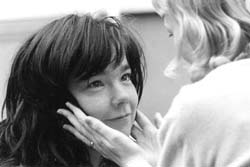|
News
|
|
|
Perspectives
|
|
|
Arts
|
|
|
Sports
|
|
|
Other
|
|

Bjork Rivets Film Audiences
Icelandic Popster Shines in von Triers' Latest Film
by James Blachly

|
|
An Army of Bjork: Bjork plays an ill-sighted immigrant mother in Dancer in the Dark. (photo courtesy www.dancerindark.com) |
These are days of fall, of internal dance, of metaphor and of beauty. In Dancer in the Dark, Lars von Triers, the eccentric Danish director, beloved by some and scorned by others, incorporates a wealth of imagery within a film that balances the heartbreaking tale of the love a mother losing her eyesight with the surreal dream-land of Bjork's music.
The film, shot nearly exclusively in Sweden and Denmark but set in Washington state in 1964, uses the American musical for its formal construction. It tells the simple story of Selma, played by Bjork, a Czechoslovakian immigrant mother who works endless hours in a factory to pay for an operation to save her son's eyesight.
But the tale is just as much about the internal musical world of Selma, and through her, the film becomes a singularly sensual experience as it incorporates social commentary with aesthetic rapture, weaving disparate elements together in a tale at once simple and complex.
At its most basic level, the film exists on a purely aesthetic plain. Von Triers uses endless series of short cinemagraphic shots (no single shot lasts longer than five or 10 seconds; many focus intensely on the face of Bjork, whose presence never seems to leave our minds) and often takes beautiful and innovative angles, incorporating fore-ground imagery in the visual landscape. Von Triers utilizes a personal, self-conscious camera technique to reflect an increasingly visually-impaired world.
As the visual world fades, sounds take on new meaning; the folding of tissue paper, a baseball card caught in the spokes of a bicycle, the anonymous sound of machinery and car engines create an aurally fascinating world that rivals that of the visual. But the film touches on messages that penetrate far deeper than is immediately apparent.
Selma, a Czechoslovakian emigre to red-scare-era America, can be seen as the representation of the ideological utopias of the 20th centuries, dedicating her life to others, creating a strong community around herself and tirelessly struggling to continue her fight, to improve the world of her son, who needs an operation to save him the genetically transmitted illness that eventually destroys Selma's eyesight over the course of the film. Like all utopian movements, Selma eventually engrosses herself in her alternate form of reality to such a degree that she is no longer functional in the larger system. Her 'daydreams,' her music, her blindness all reflect this. Selma's destruction is ultimately caused by her peaceful, harmonious vision, which excludes the harsh reality of the world around her, a world that calls to mind issues such as abortion rights and the death penalty.
Her foil in the film is Bill (David Morse), the arch-typical American figure of a cop who eats big meals, drinks beer, watches games on television and sits in his car thinking about his wife, a man who lives for endless capitalist consumption. The two act out a tale that is distinctly reflective of international politics, with economic and emotional complications, betrayal and intrigue. At the same time, it is also a very simple story.
On another level, the film is a simple tale of survival, of a magnetic, loving personality, and of honesty. As Selma loses her eyesight, she relies increasingly on all those around her who love her, particularly her friend Cathy (Catherine Deneuve). And she is as appealing to the audience as she is to those within the film; we are compelled by her unrelenting diligence, her single-minded selflessness, her undying love for her son, and her world of music (all of which is composed and performed by Bjork).
At first, these musical sections come as a surprise. After preparing the way for what appears to be inevitable disaster in the workplace, von Triers suddenly transforms a terrifying scene portraying Selma's loss of eyesight, widening the camera angle to show a pseudo-broadway dance-number with the whole factory dancing to the natural rhythm of the very machines which, not thirty seconds earlier, appeared frightening.
And the following musical interludes transition no more smoothly; they cohere not at all to the reality of the situation or plot. But by the later songs (and dances), we are accustomed to these shifts of reality, understanding them as an integral part of Von Triers's artistic vision and accepting the songs at their own intrinsic value, focusing less on the awkwardly obvious nature of the rhyme scheme and allowing, instead, Bjork's insistent, visionary music to penetrate our world. As you leave the theatre, you may even find these songs reverberating in your mind. "Why do I love it so much?" Bjork sings, "it's just another musical."
Von Triers most recent creation may utilize a prototypical musical form, but it must be understood as the utilization of a familiar form to achieve uncommon ends. And the film comments on itself; Jeff, Selma's persistent suitor, says "I just don't understand musicals. In real life, people don't just start singing. I don't just start singing all the time. I talk." But perhaps that is the point, really: like Selma, we can live our lives with music. We can live outside of the ordinary. True, one does not function within society with one's eyes closed.
But it is beautiful.
Copyright © 2000, The Oberlin Review.
Volume 129, Number 6, October 27, 2000
Contact us with your comments and suggestions.